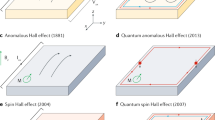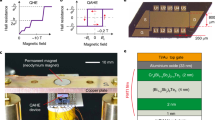Abstract
The integer quantum Hall effect (IQHE) is analysed, considering the degeneracies of localized and extended states separately. Occupied localized and extended states are counted, and their variation is studied as a function of magnetic field. The number of current-carrying electrons is found to have a saw-tooth variation with magnetic field. The analysis addresses certain basic questions in the IQHE, particularly the one about floatation of extended states as the magnetic field tends to zero.
Similar content being viewed by others
References
K. von Klitzing, G. Dorda, and M. Pepper, Phys. Rev. Lett. 45, 494 (1980).
D. Shoenberg, Magnetic Oscillations in Metals (Cambridge University Press, 1984) also pointed out (p. 159) that the IQHE result [1] should imply a saw-tooth variation of the number of mobile electrons with magnetic field but did not give a mechanism for it.
E. Abraham, P. W. Anderson, D. C. Licciardello, and T. V. Ramakrishnan, Phys. Rev. Lett. 42, 673 (1979).
D. E. Khmelnitskii, Phys. Lett. 106A, 182 (1984). R. B. Laughlin, Phys. Rev. Lett. 52, 2304 (1984). K. Yang and R.N. Bhatt, ibid 76, 1316 (1996). F. D. M. Haldane and K. Yang, ibid 78, 298 (1997), and references therein.
D. Z. Liu, X. C. Xie, and Q. Niu, Phys. Rev. Lett. 76, 975 (1996). D. N. Sheng and Z. Y. Weng, ibid 78, 318 (1997), and references therein.
The Hall voltage E y(B) = h(le 2)j x = B/[ls(B)e]j x along the lth plateau with the system current j x fixed at N ev(N = No. density of electrons in the system, v = drift velocity). Note that exactly ls(B) states matter eventhough N may be > or even < ls(B). See also J. Riess Physica B 204, 124 (1995), and the references therein.
We have not taken edge states into account which are known to play an important role in transport at least at low applied biases. So, the present analysis may be more suitable for large currents when the Hall field is large and the bulk currents due to the drift velocity dominate over the edge currents.
R. B. Laughlin, Phys. Rev. B 23, 5632 (1981).
The E y is typically of order 10−5 volts/m; s E(B) = s(B)/(D+1), where s(B) ∼ 109 per mm2 for B ∼ 10 T.
It is also arguable whether the regime of the IQHE where the saw-tooth behaviour is expected to be observed is likely to overlap with the regime where the extended states float up above the Fermi level. If the experiment shows a clear tendency of the N/(D +1) line converging to a point well above B = 0, then this could be taken as an indication that the two regimes overlap.
See, e.g., Y. Huo and R. N. Bhatt, Phys. Rev. Lett. 68, 1375 (1992).
Author information
Authors and Affiliations
Rights and permissions
About this article
Cite this article
Srivastava, V. Arithmetic of the Integer Quantum Hall Effect. Found Phys Lett 11, 561–571 (1998). https://doi.org/10.1023/A:1022184825595
Published:
Issue Date:
DOI: https://doi.org/10.1023/A:1022184825595




